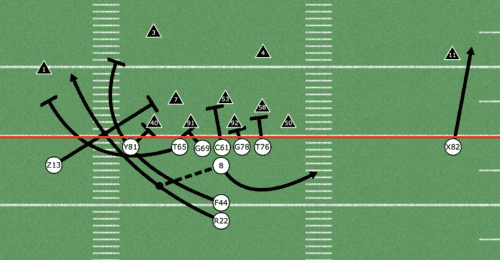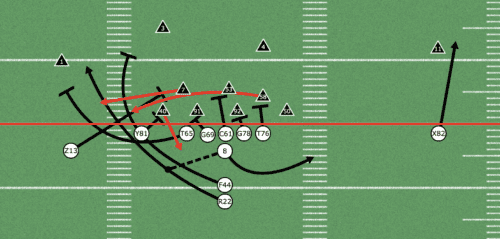Steelers Analysis
Film Room with Kevin Dotson: What’s Bogging Down Steelers Rushing Attack?

PITTSBURGH — To say that the Pittsburgh Steelers running game is struggling would be an understatement, but the reasons for that struggle are myriad.
The Steelers have trailed in every game they’ve been in this season, which certainly hasn’t helped them pile up rushing yards, but they’re not doing very well on a per-play basis, either. The Steelers have averaged 3.9 yards per rush attempt, which is tied for 24th in the NFL.
Part of that criticism has fallen to Najee Harris, who has underwhelmed in his second season as the team’s starting running back. Head coach Mike Tomlin said Tuesday that rookie Jaylen Warren will continue to get more carries if he continues to be the more-productive of the team’s backs.
But Warren’s 4.9 yards per carry isn’t exactly on a record-breaking pace, either. If he had enough carries to qualify, it would put him into a tie for 15th-best in the NFL, alongside Breece Hall and Travis Etienne.
Warren did get some garbage time against the Buffalo Bills on Sunday, and that probably helped his totals. But what happened earlier in that game, when the Steelers were trailing, but still weren’t able to run the ball, despite trying over and over again?
Let’s take a look at the film. Here’s a play from the Steelers’ first drive of the game, a toss sweep out of the I-formation, a play that’s been run at all levels of football for probably 40 years with a great deal of success.
The Steelers only variation to the usual theme is a slight flexing of tight end Zach Gentry to give him a better angle on Bills defensive end Von Miller. Kenny Pickett also executes a backside fake at the end of the play in an attempt to hold the backside safety. Otherwise, this is as basic as it gets.
The design of the play is simple. Left tackle Dan Moore Jr. is supposed to pull around Gentry and kick out the corner. Receiver Miles Boykin crashes the play-side linebacker. Fullback Derek Watt leads Harris through the hole created and handles the strong safety, leaving Harris in a footrace with the backside safety and a full head of steam.
The Bills line up in a very standard 4-2 Nickel front, with the strong-side linebacker shaded away from the play to the middle of the field and strong safety Damar Hamlin far off the ball. If blocked correctly, this play has the potential to be an easy 10-yard gain, and much more if Harris can break one tackle.

(Excuse the hash marks on this play diagram, it’s designed for high school football.)
Instead, Harris lost two yards. So what went wrong?
The Steelers had three critical missed blocking assignments. Any one of them would not have been fatal to the rest of the play, but taken in tandem, they sank any chance of Harris even being able to get back to the line of scrimmage.
Let’s start with Miller. He knifes off the line of scrimmage to the inside of Gentry, filling the space that Moore needs to pull around the tight end. Moore runs into Gentry, Watt has to slow down waiting for Moore, and the impact is that it takes the whole train of blockers a lot longer than it should to emerge on the edge of the formation.
Of the three defenders on the second level, only one got blocked, as Miles Boykin was quickly beaten by slot corner Taron Johnson and Chuks Okorafor could not climb quickly enough to get to weak-side linebacker Matt Milano.

So when the Watt-Moore calvary arrived, late to the party on the edge, Watt had to pick between three defenders: Hamlin, his assignment, and Milano and Johnson to the inside and closer to him.
It could be argued that Watt should have keep stringing the play out and tried to make a hole between Harris and Hamlin, but there just isn’t a lot of room there by the time everyone gets into position. The entire timing of the play was thrown off when Miller beat Gentry to the inside, which was something the Steelers weren’t expecting.
“He did the opposite of what he would usually do on that play,” guard Kevin Dotson explained. “That’s a whole different variable. So we knew what he was supposed to do. And him being him, he kinda has free rein to do when he feels like. And he just kinda ran up in there. when usually he would see that tight end looking at him and it wouldn’t be him going up field. So, you know, just got to do what you can when it does happen.”
Even without Miller’s disruption, though, it’s probably still not a negative play if not for Boykin and Okorafor also failing to secure their blocks. Especially Boykin, who plays minimally and it sure looks like was put into the game specifically for his blocking on this play. That’s where things really snowballed.
That’s an instance where the blocking let the team down. Other times, the answer lies more clearly on the ball-carrier. In the second quarter, the Steelers ran an inside handoff to Harris on a 2nd and 2 out of a bunch formation to the play side.
The play was clearly called to go inside of the tight end Gentry, who turned his defensive end outside. But Harris approached Gentry with not a single Buffalo player outside the hash mark, and his momentum taking him toward that sideline. All he had to do was keep running and he would have easily gained the first down, and maybe a lot more.
Instead, Harris tried to fake outside and cut back into the hole, neither Chase Claypool nor George Pickens got a block, and the play was stuffed. The Steelers threw an incomplete pass on third down and punted.
The thing about running the football is that it takes most of the 11 men on the field to execute in concert. It only takes one thing going wrong to sink the whole enterprise. Sometimes, that can be the back. But it can also be almost any of the other players on the field, including wide receivers.
“I feel like it’s missed opportunities and situations,” Dotson said. “Sometimes we do have a good block and it just don’t go. Sometimes we’re down so you can’t really run as much as you would like.”
The Steelers don’t have one big problem they can fix with the running game, they have a 100 small ones, and that makes for a much more difficult solution.














